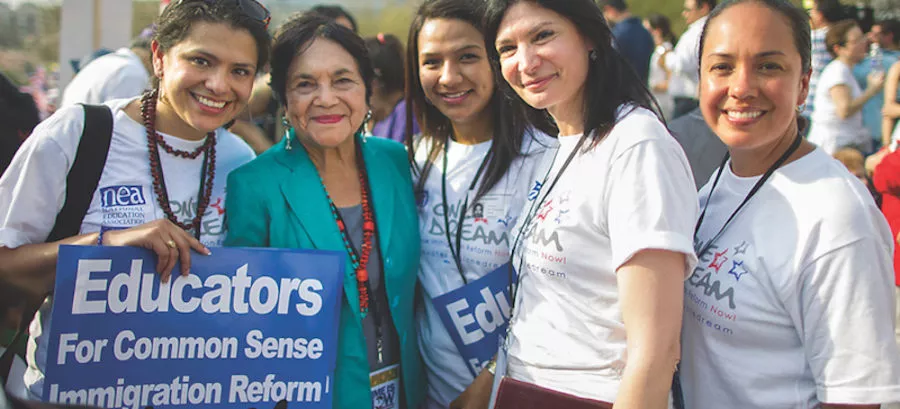In 1857, 100 teachers united as one voice on behalf of public education. NEA has worked since then to improve the conditions in which educators work and students learn.
When the organization was founded, reading and writing was a privilege for most children, and it was a crime for enslaved Africans to learn to read.
 Today, public education and the teaching profession work to ensure that every American child receives a free education, despite race or gender, citizenship, religion or spoken language, social class or disability. Here's a look at NEA's important work through the decades:
Today, public education and the teaching profession work to ensure that every American child receives a free education, despite race or gender, citizenship, religion or spoken language, social class or disability. Here's a look at NEA's important work through the decades:
1954: At the 1954 Representative Assembly in New York City, the Association adopted a resolution that urged all citizens to approach integration in public schools with the spirit of fair play and good will.
1964: NEA lobbies to pass the Civil Rights Act.
1966: Merger between NEA and the historically Black American Teachers Association takes place.
1968: NEA leads the effort to establish the Bilingual Education Act
1972: In the first case ever litigated on behalf of a gay K-12 teacher, NEA funds a federal lawsuit against Maryland’s Montgomery County Board of Education.
 Education for All Handicapped Children Act passes in 1975.
Education for All Handicapped Children Act passes in 1975.
1974: U.S. Supreme Court case backed by NEA makes it unlawful to fire pregnant teachers or force maternity leave. At the NEA Representative Assembly, delegates support Title IX by adopting a resolution that affirms the Association's commitment to providing male and female students with an equal opportunity to participate in athletic programs at all educational levels.
1975: NEA works for passage of the Education for All Handicapped Children Act—now known as the Individual with Disabilities Education Act—which opens the door for many students with physical disabilities to attend public schools.
1984: NEA wins passage of a federal retirement equity law, which ends the ability of retirement funds to discriminate against women.
1987: NEA releases “And Justice for All,” a series of reports—and first of its kind— on the education of black, Hispanic, American Indian/Alaska Native, and Asian and Pacific Islander students. The report reveals serious barriers preventing students of color from obtaining an adequate/excellent education and underscores the need to create equality of educational opportunities for all students.
 Shannon Faulkner
Shannon Faulkner
1993: NEA provides first local leader training to local presidents incorporating issues and concerns of gay, lesbian, and bisexual employees.
1994: Shannon Faulkner endures insults, intimidation, and death threats for trying to attend The Citadel—a state-supported military college that for more than 150 years barred admission to women. NEA signs onto friend-of the-court briefs supporting the challenges to single-sex institutions.
2005: As key provisions of the Voting Rights Act are set to expire, NEA lobbies for reauthorization.
2013: NEA is a vocal, unequivocal advocate of commonsense immigration reform, pushing Congress to stand by Dreamers; preserve the unity of family, and create
a realistic path to citizenship for the 11 million aspiring citizens who already call America home.
2016: NEA Representative Assembly delegates adopt a resolution to prevent acts of discrimination and violence targeted at people who identify as LGBTQ. The Association
files several amicus briefs challenging discriminatory laws, including North Carolina’s H.B. 2., which bans transgender people from using the bathroom of the gender with which they identify.
 (AP Photo/Andres Kudacki)
(AP Photo/Andres Kudacki)
2018: NEA files an amicus brief on President Donald Trump’s Executive Order banning
travelers and refugees from certain Muslim-majority countries, stating that the ban violates the Constitution’s Establishment Clause by disfavoring a religious group and gives oxygen to the fires of bias, bullying, and discord. NEA launches #BlackLivesMatteratSchool, a site that provides educators with resources for discussions about race, highlights stories of educators and students who have stood together for racial justice, and links to art and videos to support and inspire activism. NEA supports thousands of educators in #RedForEd, a national movement that lifts the veil on inequity in public education.
Visit NEA EdJustice to learn more.


